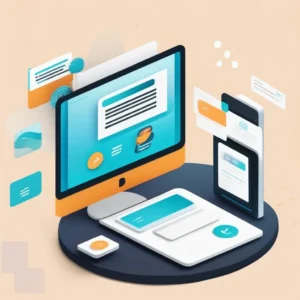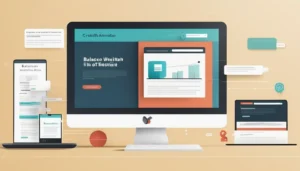Are you Tired of boring websites? Animations are the secret sauce to capturing attention. To truly captivate and engage users, websites must be dynamic and interactive. Enter animations. These visual elements are no longer just a fancy add-on; they’ve become essential tools for enhancing user experience. Animations can transform a dull webpage into an immersive journey, guiding users effortlessly and leaving a lasting impression. In This blog, we will explore the top 10 best animations for the website that can supercharge your website and elevate it to new heights.
Enhance User Experience with These Top 10 Animation Techniques 1
Best Practices for Using Animations 2
Animation Tools and Techniques 3
Enhance User Experience with These Top 10 Animation Techniques

Hover Effects
Make elements come alive! Hover effects, like images growing or colors changing when you mouse over, grab attention and encourage exploration. Imagine a product image zooming in or a button subtly glowing – it’s like adding a touch of magic to your website.
Loading Indicators
Nobody likes waiting. Creative loading animations, like progress bars or spinning shapes, can trick your brain into thinking things are loading faster. Plus, they look cool!
Micro-interactions
Small details matter. Animations for things like button clicks or form submissions give users that satisfying “click” feeling. It’s like getting a little pat on the back for completing a task.
Hero Image Animations
Your hero image is your website’s first impression. Adding subtle movement, like parallax scrolling or gentle swaying, can make it more captivating and memorable.
Scroll Animations
Tell a story as users scroll. Elements fading in or moving with the page create a dynamic and engaging experience. It’s like watching a mini-movie as you explore the site.
Call-to-Action (CTA) Animations
Get people to click! Animated buttons or subtle movements draw attention to your CTAs, making them more irresistible. A gently pulsing “Buy Now” button can be the nudge your visitors need.
Navigation Animations
Smooth sailing! Animated dropdown menus or hamburger menus make navigation a breeze. It’s like having a helpful assistant guiding you through the website.
Onboarding Animations
Welcome to the party! Onboarding animations, like tooltips or guided tours, help new users feel at home. They’re like friendly tour guides showing you the ropes.
Error Animations
Mistakes happen. Turn errors into opportunities with friendly animations and helpful messages. It’s like a virtual hug after a website mishap.
- Error animations can soften the blow of an error, provide helpful feedback, and even make the user smile. They show that you care about user experience.
- Examples: Cute characters apologizing for the error, playful animations that indicate something went wrong, or helpful tips on how to fix the issue
Background Animations
Set the mood! Subtle background animations, like falling particles or gentle patterns, can create a calming or exciting atmosphere. It’s like adding a soundtrack to your website.
Best Practices for Using Animations

Balance and Restraint
Animations can be powerful, but too many can overwhelm users and slow down your website. Less is often more. Use animations strategically to enhance specific elements, rather than applying them indiscriminately.
- Focus on purpose: Every animation should serve a clear purpose, whether it’s improving usability, enhancing engagement, or providing feedback.
- Prioritize user experience: Animations should complement the overall user experience, not distract from it.
- Consider the context: The type of animation should match the content and tone of your website.
Performance Optimization
Animations can impact website performance if not optimized correctly. Slow animations can frustrate users and hurt your search engine rankings.
- Choose the right format: Use lightweight formats like SVG or CSS animations when possible.
- Optimize image sizes: Ensure images used in animations are compressed without sacrificing quality.
- Minimize resource-intensive effects: Avoid overly complex animations that strain device resources.
- Test performance: Regularly check your website’s loading speed and responsiveness with different browsers and devices.
Accessibility
Animations should be inclusive and accessible to all users, including those with disabilities.
- Provide alternative content: Use text descriptions for animations to assist users with visual impairments.
- Controllable animations: Allow users to pause, stop, or hide animations if desired.
- Avoid motion sickness: Excessive motion can cause discomfort for some users.
- Consider color contrast: Ensure animations have sufficient color contrast for visibility.
Testing Across Devices and Browsers
Animations can behave differently on different devices and browsers. Thorough testing is essential for a consistent user experience.
- Test on various devices: Check how animations look and perform on desktops, laptops, tablets, and smartphones.
- Test on different browsers: Ensure compatibility across popular browsers like Chrome, Firefox, Safari, and Edge.
- Consider screen sizes and resolutions: Adapt animations to fit different screen dimensions.
- Check for responsiveness: Verify that animations respond appropriately to user interactions and screen orientation changes.
Animation Tools and Techniques
Design Tools with Animation Capabilities
- Adobe After Effects: A powerful tool for complex animations and visual effects.
- Figma: Offers interactive prototyping and basic animation features.
- Adobe XD: Provides animation capabilities for user interface design.
- Sketch: Known for its vector graphics, but also includes animation features.
Web-Based Animation Tools
- Lottie: A popular format for exporting animations from After Effects and using them in web projects.
- Green Sock (GSAP): A JavaScript library for creating high-performance animations.
- CSS Animations: Built-in browser capabilities for simple animations.
Key Animation Techniques
- CSS Transitions: For smooth changes in properties like opacity, color, and size.
- CSS Keyframes: For creating complex animations with multiple keyframes.
- JavaScript Libraries: For advanced animations and interactions.
- SVG Animations: For vector-based animations that are scalable and responsive.
Tips for Choosing the Right Tool
- Consider the complexity of your animation.
- Evaluate the ease of use and learning curve.
- Assess the compatibility with your design workflow.
- Explore the available features and export options.
By understanding the different tools and techniques, you can select the best approach for your animation project and create stunning visual experiences.
Conclusion
These top 10 animation techniques can significantly enhance your website’s user experience. Hover effects, loading indicators, and micro-interactions capture attention and provide feedback. Hero image and scroll animations create engaging stories, while animated CTAs and navigation improve usability. Onboarding animations welcome new users, error animations soften mistakes, and background animations set the mood. Remember to use animations sparingly, optimize for performance, ensure accessibility, and test across devices. Thoughtfully integrating these animations will create a memorable and enjoyable website experience.
bring your website to life with animation Transform Your Ideas into Motion. Contact Us at Mas Studio to get started today
